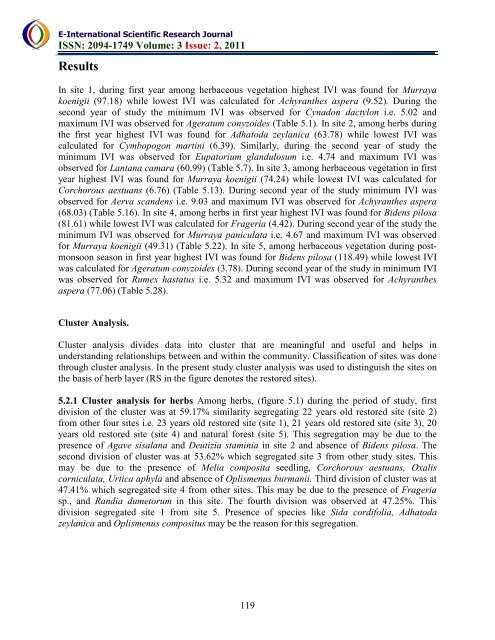download the full article here - E-International Scientific Research ...
download the full article here - E-International Scientific Research ...
download the full article here - E-International Scientific Research ...
You also want an ePaper? Increase the reach of your titles
YUMPU automatically turns print PDFs into web optimized ePapers that Google loves.
E-<strong>International</strong> <strong>Scientific</strong> <strong>Research</strong> Journal<br />
ISSN: 2094-1749 Volume: 3 Issue: 2, 2011<br />
Results<br />
In site 1, during first year among herbaceous vegetation highest IVI was found for Murraya<br />
koenigii (97.18) while lowest IVI was calculated for Achyran<strong>the</strong>s aspera (9.52). During <strong>the</strong><br />
second year of study <strong>the</strong> minimum IVI was observed for Cynadon dactylon i.e. 5.02 and<br />
maximum IVI was observed for Ageratum conyzoides (Table 5.1). In site 2, among herbs during<br />
<strong>the</strong> first year highest IVI was found for Adhatoda zeylanica (63.78) while lowest IVI was<br />
calculated for Cymbopogon martini (6.39). Similarly, during <strong>the</strong> second year of study <strong>the</strong><br />
minimum IVI was observed for Eupatorium glandulosum i.e. 4.74 and maximum IVI was<br />
observed for Lantana camara (60.99) (Table 5.7). In site 3, among herbaceous vegetation in first<br />
year highest IVI was found for Murraya koenigii (74.24) while lowest IVI was calculated for<br />
Corchorous aestuans (6.76) (Table 5.13). During second year of <strong>the</strong> study minimum IVI was<br />
observed for Aerva scandens i.e. 9.03 and maximum IVI was observed for Achyran<strong>the</strong>s aspera<br />
(68.03) (Table 5.16). In site 4, among herbs in first year highest IVI was found for Bidens pilosa<br />
(81.61) while lowest IVI was calculated for Frageria (4.42). During second year of <strong>the</strong> study <strong>the</strong><br />
minimum IVI was observed for Murraya paniculata i.e. 4.67 and maximum IVI was observed<br />
for Murraya koenigii (49.31) (Table 5.22). In site 5, among herbaceous vegetation during postmonsoon<br />
season in first year highest IVI was found for Bidens pilosa (118.49) while lowest IVI<br />
was calculated for Ageratum conyzoides (3.78). During second year of <strong>the</strong> study in minimum IVI<br />
was observed for Rumex hastatus i.e. 5.32 and maximum IVI was observed for Achyran<strong>the</strong>s<br />
aspera (77.06) (Table 5.28).<br />
Cluster Analysis.<br />
Cluster analysis divides data into cluster that are meaningful and useful and helps in<br />
understanding relationships between and within <strong>the</strong> community. Classification of sites was done<br />
through cluster analysis. In <strong>the</strong> present study cluster analysis was used to distinguish <strong>the</strong> sites on<br />
<strong>the</strong> basis of herb layer (RS in <strong>the</strong> figure denotes <strong>the</strong> restored sites).<br />
5.2.1 Cluster analysis for herbs Among herbs, (figure 5.1) during <strong>the</strong> period of study, first<br />
division of <strong>the</strong> cluster was at 59.17% similarity segregating 22 years old restored site (site 2)<br />
from o<strong>the</strong>r four sites i.e. 23 years old restored site (site 1), 21 years old restored site (site 3), 20<br />
years old restored site (site 4) and natural forest (site 5). This segregation may be due to <strong>the</strong><br />
presence of Agave sisalana and Deutizia staminia in site 2 and absence of Bidens pilosa. The<br />
second division of cluster was at 53.62% which segregated site 3 from o<strong>the</strong>r study sites. This<br />
may be due to <strong>the</strong> presence of Melia composita seedling, Corchorous aestuans, Oxalis<br />
corniculata, Urtica aphyla and absence of Oplismenus burmanii. Third division of cluster was at<br />
47.41% which segregated site 4 from o<strong>the</strong>r sites. This may be due to <strong>the</strong> presence of Frageria<br />
sp., and Randia dumetorum in this site. The fourth division was observed at 47.25%. This<br />
division segregated site 1 from site 5. Presence of species like Sida cordifolia, Adhatoda<br />
zeylanica and Oplismenus compositus may be <strong>the</strong> reason for this segregation.<br />
119

















